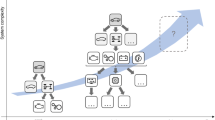Abstract
Improving simulation performance using activity tracking has attracted attention in the modeling field in recent years. The reference to activity has been successfully used to predict and promote the simulation performance. Tracking activity, however, uses only the inherent performance information contained in the models. To extend activity prediction in modeling, we propose the activity enhanced modeling with an activity meta-model at the meta-level. The meta-model provides a set of interfaces to model activity in a specific domain. The activity model transformation in subsequence is devised to deal with the simulation difference due to the heterogeneous activity model. Finally, the resource-aware simulation framework is implemented to integrate the activity models in activity-based simulation. The case study shows the improvement brought on by activity-based simulation using discrete event system specification (DEVS).
Similar content being viewed by others
References
Balsamo, S., di Marco, A., Inverardi, P., et al., 2004. Model-based performance prediction in software development: a survey. IEEE Trans. Softw. Eng., 30(5):295–310. [doi:10.1109/TSE.2004.9]
Boukerche, A., Das, S.K., 1997. Dynamic load balancing strategies for conservative parallel simulations. Proc. 11th Workshop on Parallel and Distributed Simulation, p.20–28. [doi:10.1109/PADS.1997.594582]
Concepcion, A.I., Zeigler, B.F., 1988. DEVS formalism: a framework for hierarchical model development. IEEE Trans. Softw. Eng., 14(2):228–241. [doi:10.1109/32.4640]
Czarnecki, K., Helsen, S., 2003. Classification of model transformation approaches. OOPSLA Workshop on Generative Techniques in the Context of Model-Driven Architecture, p.1–17.
D’Abreu, M.C., Wainer, G.A., 2005. M/CD++: modeling continuous systems using Modelica and DEVS. 13th IEEE Int. Symp. on Modeling, Analysis, and Simulation of Computer and Telecommunication Systems, p.229–236. [doi:10.1109/MASCOTS.2005.36]
Deelman, E., Szymanski, B.K., 1998. Dynamic load balancing in parallel discrete event simulation for spatially explicit problems. Proc. 12th Workshop on Parallel and Distributed Simulation, p.46–53. [doi:10.1109/PADS.1998.685 269]
Emerson, M., Sztipanovits, J., 2006. Techniques for metamodel composition. 6th Workshop on Domain Specific Modeling, p.123–139.
Guo, G., 2013. User Manual of OneModel. National University of Defense Technology, Changsha, China (in Chinese).
Hu, X.L., Ntaimo, L., 2006. Dynamic multi-resolution cellular space modeling for forest fire simulation. Proc. Spring Simulation Multi-conf., p.95–102.
Hu, X.L., Ntaimo, L., 2008. DEVS-FIRE: towards an integrated simulation environment for surface wildfire spread and containment. Simulation, 84(4):137–155. [doi:10.1177/0037549708094047]
Hu, X.L., Zeigler, B.P., 2013. Linking information and energy—activity-based energy-aware information processing. Simulation, 89(4):435–450. [doi:10.1177/0037549711400778]
Hu, X.L., Muzy, A., Ntaimo, L., 2005. A hybrid agent-cellular space modeling approach for fire spread and suppression simulation. Proc. Winter Simulation Conf., p.248–255. [doi:10.1109/WSC.2005.1574258]
Jammalamadaka, R., 2003. Activity Characterization of Spatial Models: Application to Discrete Event Solution of Partial Differential Equations. PhD Thesis, the University of Arizona, Tucson, USA.
Kelly, S., Tolvanen, J.P., 2008. Domain-Specific Modeling: Enabling Full Code Generation. Wiley-IEEE Computer Society Press, USA.
Lagerström, R., Chenine, M., Johnson, P., et al., 2008. Probabilistic metamodel merging. CAiSE Forum, p.25–28.
MacNeil, T., 2004. Don’t be misled by MIPS. IBM Systems Magazine Webinars.
Muzy, A., Zeigler, B.P., 2008. Introduction to the activity tracking paradigm in component-based simulation. The Open Cybern. Syst. J., 2:30–38.
Muzy, A., Nutaro, J.J., Zeigler, B.P., et al., 2008. Modeling and simulation of fire spreading through the activity tracking paradigm. Ecol. Model., 219(1–2):212–225. [doi:10.1016/j.ecolmodel.2008.08.017]
Muzy, A., Touraille, L., Vangheluwe, H., et al., 2010. Activity regions for the specification of discrete event systems. Proc. Spring Simulation Multi-conf., p.1–7. [doi:10.1145/1878537.1878679]
Muzy, A., Jammalamadaka, R., Ziegler, B.P., et al., 2011. The activity-tracking paradigm in discrete-event modeling and simulation: the case of spatially continuous distributed systems. Simulation, 87(5):449–464. [doi:10.1177/0037549710365155]
Petriu, D.C., Shen, H., 2002. Applying the UML performance profile: graph grammar-based derivation of LQN models from UML specifications. Proc. 12th Int. Conf. on Modelling Tools and Techniques for Computer and Communication System Performance Evaluation, p.159–177.
Qiu, F.S., Hu, X.L., 2013. Spatial activity-based modeling for pedestrian crowd simulation. Simulation, 89(4):451–465. [doi:10.1177/0037549711435950]
Sendall, S., Kozaczynski, W., 2003. Model transformation: the heart and soul of model-driven software development. IEEE Softw., 20(5):42–45. [doi:10.1109/MS.2003.1231 150]
Shibata, D., Alfenas, D., Guiraldelli, R., et al., 2012. Activity based scheduling simulator for product transport using pipeline networks. Proc. Winter Simulation Conf., p.1–12.
Syriani, E., Vangheluwe, H., 2007. Programmed graph rewriting with DEVS. 3rd Int. Symp. on Applications of Graph Transformations with Industrial Relevance, p.136–151. [doi:10.1007/978-3-540-89020-1_11]
Vangheluwe, H., 2000. DEVS as a common denominator for multi-formalism hybrid systems modelling. IEEE Int. Symp. on Computer-Aided Control System Design, p.129–134. [doi:10.1109/CACSD.2000.900199]
Vangheluwe, H., de Lara, J., 2004. Computer automated multi-paradigm modelling for analysis and design of traffic networks. Proc. Winter Simulation Conf., p.249–258.
Welling, L., Thomson, L., 2003. PHP and MySQL Web Development. Sams Publishing, USA.
Zeigler, B.P., Praehofer, H., Kim, T.G., 2000. Theory of Modeling and Simulation (2nd Ed.). Academic Press, USA.
Zeigler, B.P., Jammalamadaka, R., Akerkar, S.R., 2004. Continuity and change (activity) are fundamentally related in DEVS simulation of continuous systems. 13th Int. Conf. on AI, Simulation, Planning in High Autonomy Systems, p.1–13.
Author information
Authors and Affiliations
Corresponding author
Additional information
Project supported by the National Natural Science Foundation of China (Nos. 71303252 and 91024030)
Rights and permissions
About this article
Cite this article
Chen, B., Zhang, Lb., Liu, Xc. et al. Activity-based simulation using DEVS: increasing performance by an activity model in parallel DEVS simulation. J. Zhejiang Univ. - Sci. C 15, 13–30 (2014). https://doi.org/10.1631/jzus.C1300121
Received:
Accepted:
Published:
Issue Date:
DOI: https://doi.org/10.1631/jzus.C1300121
Key words
- Activity tracking
- Activity enhanced modeling
- Discrete event system specification (DEVS)
- Resource-aware simulation framework




